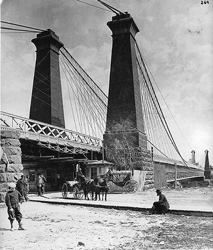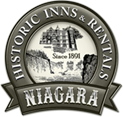Niagara Falls History & Human History
The first humans arrived in Niagara Region almost 12,000 years ago, just in time to witness the birth of the Falls. The land was different then, consisting of tundra and spruce forest. During this time (the Palaeo-Indian Period, which lasted until 9,000 years ago), Niagara was inhabited by the Clovis people. These nomadic hunters likely camped along the old Lake Erie shoreline, living in simple, tiny dwellings. They left little to mark their tenure except chipped stones. These large, fluted projectile points were likely to fell the caribou, mastodons, moose and elk that roamed the land.
By 9,500 years ago a deciduous forest apparently covered southernmost Ontario. This forest supported the hunter-gatherers of the Archaic Period (9,000 to 3,000 years ago) with a diet of deer, moose, fish and plants. Small groups hunted in the winter, feeding on nuts and animals attracted to the forest. Larger groups came together during the summer, setting up fishing camps at the mouths of rivers and along lakeshores.
The Woodland Period lasted from 3,000 to 300 years ago, culminating in the peak of Iroquois culture in southern Ontario. Corn, bean and squash agriculture provided the main sources of food. With their bellies full, the Iroquois had time for other pursuits and the population boomed. Small palisaded villages were built, with nuclear or extended families occupying individual longhouses. During this period, burial rituals and ceramics were introduced to Ontario. Society became more complex with a political system based on extended kinship and inter-village alliances.
When the European explorers and missionaries arrived at the beginning of the 17th Century, the Iroquoian villages were under the direction of various chiefs elected from the major clans. In turn, these villages were allied within powerful tribal confederacies.
Unfortunately, inter-tribal warfare with the Five Nations Iroquois of New York State, made worse by the intrusion of the Europeans, dispersed the three Ontario confederacies, the Huron, the Petun and the Neutral. Niagara ceased to be the territory of those who lived in harmony with nature. Still, this fascinating period of native occupation cries out for interpretation and study. Since human settlement requires drinking water, sites within 150 metres of rivers and lakeshores have the greatest archaeological potential. Palaeo-Indian sites in Niagara would most likely be associated with the series of relic beach ridges that once formed the shore of early Lake Erie.
In May 1535, Jacques Cartier left France to explore the New World. Although he never saw Niagara Falls, the Indians he met along the St.Lawrence River told him about it. Samuel de Champlain visited Canada in 1608. He, too, heard stories of the mighty cataract, but never visited it. Etienne Brule, the first European to see Lakes Ontario, Erie Huron and Superior, may also have been the first to behold the Falls, in 1615.
That same year, the Recollet missionary explorers arrived in Ontario. They were followed a decade later by the Jesuits. It was a Jesuit father, Gabriel Lalemant, who first recorded the Iroquios name for the river- Onguiaahra, meaning "the Strait". "Niagara" is a simplification of the original.
In 1651, during the fur- trade rivalry between the Huron and Iroquois that was first precipitated by the French, the Iroquois wiped out the Neutrals. Until the American Revolution, they managed to keep white settlers out of Niagara almost completely.
In December 1678, Recollet priest Louis Hennepin visited Niagara Falls. Nineteen years later, he published the first engraving of the Falls in his book Nouvelle Decouverte. The Falls obviously made a great impression of Hennepin, for he estimated their height to be 183 metres, more than three times what it really is.
In 1812, by request of President James Madison, the United States congress declared war on Canada. Artifacts from that war dot the riverside, as do monuments erected later, such as the one to Sir Isaac Brock. Recently, the skeletons of members of the U.S. Army were found near Old Fort Erie.
Following the War of 1812, the region began the slow process of rebuilding itself. Queenston became a bustling community, but Chippawa was the big centre, with distilleries and factories.
In the 1820's, a stairway was built down the bank at Table Rock and the first ferry service across the lower River began. By 1827, a paved road had been built up from the ferry landing to the top of the bank on the Canadian side. This site became the prime location for hotel development and the Clifton was built there, after which Clifton Hill is named.
Niagara has perhaps the most complex transportation history of any area in North America. The first Welland Canal was completed in 1829. Between 1849 and 1962, thirteen bridges were constructed across the Niagara River Gorge. Four of them remain.
The roadway between Niagara-on-the-Lake and Chippawa was the first designated King's Highway. The first stage coach in Upper Canada operated on this roadway between the late 1700s and 1896. The first railroad in Upper Canada opened in 1841 with horse-drawn carriages running between Chippawa and Queenston. In 1854 it was converted to steam and relocated to serve what was to become the Town of Niagara Falls.
In 1855, John August Roebling, the designer of the Brooklyn Bridge, built the Niagara Railway Suspension Bridge, the first bridge of its type in the world. Between the late 1700s and the middle 1800s, boats were the main way to get to Niagara Falls. By 1896, three boats plied the route between Toronto and Queenston.
One of the first electrified street car services was provided in Niagara, and in 1893 the Queenston/Chippawa Railway carried boat passengers from Queenston to Table Rock and beyond. In 1902, a railway was constructed across the Queenston Suspension Bridge. Later it was extended along the lower Gorge on the American side of the River, connecting back into Canada at the Upper Arch Bridge. This transit line, the Great Gorge Route, continued in service until the Depression. The use of boats declined as tourists increasingly chose to visit Niagara by automobile, bus or train.
Tourism travel to the Falls began in the 1820s and within 50 years it had increased ten-fold to become the area's dominant industry.
After World War 1, automobile touring became popular. As a response, attractions and accommodations sprang up in strip developments, much of which still survives.





